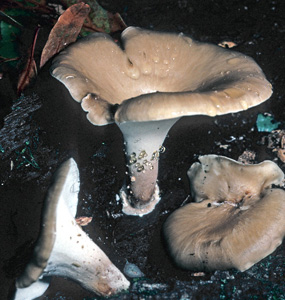Royoporus badius

Image Courtesy of Emily Johnson
| Click to Enlarge |
| Click For Image Gallery |
|
Group of Fungi: Polypores Family: Polyporaceae Latin Name: Royoporus badius (Pers.) A.B. De Synonym(s):
Common Name: Black-footed Polypore Description: Total height 1–3 in (1.5–7.5 cm); cap 2–8 in (5–20 cm) wide, convex to shallow plate-shaped, circular or somewhat irregular, upper surface dark reddish brown but becoming darker in age, darker near the center and paler towards the margin, smooth, tough and leathery texture; margin wavy; spore-bearing surface white to cream or buff, pores very small and difficult to see; stalk 3/4–2 1/2 in (2–6.5 cm) long, 1/8–5/8 in (0.3–1.5 cm) in diameter, usually off-center, upper portion white to pallid and lower portion black (hence the common name), smooth, tapering downward; spores white in mass. Biological Role: Decomposer of wood. Habitat: On decaying logs, stumps and wood debris of broadleaf trees or more rarely conifers; occurring as solitary fruiting bodies or in small groups. Geographical Distribution: Widely distributed throughout eastern North America. Comments: The fruiting bodies of Royoporus badius are fairly easy to spot, and their tough, leathery texture and the black base of the stalk are features not shared with any other relatively common fungus one is likely to encounter in nature. Polyporus varius is very similar in overall structure but has a smaller cap with a light brown to nearly white upper surface. Both species are much too tough to be considered suitable for human consumption. |
| Go Back |